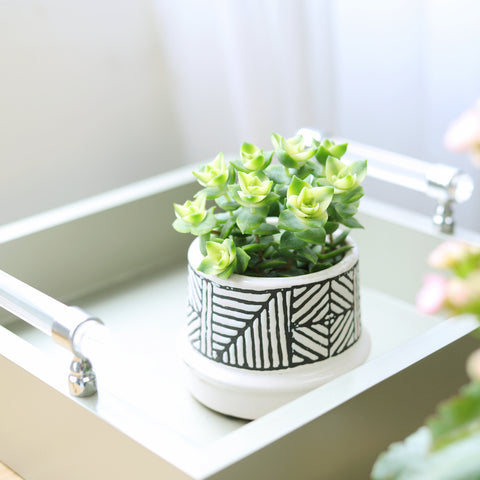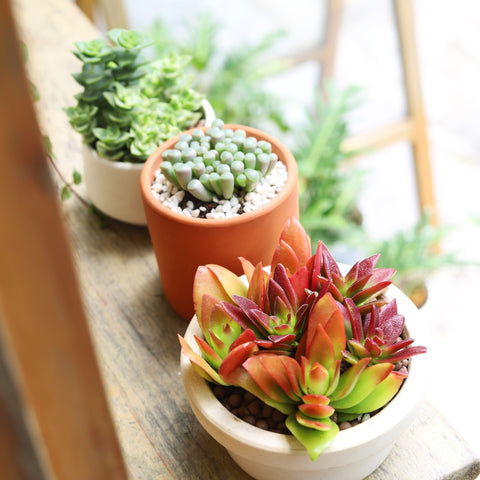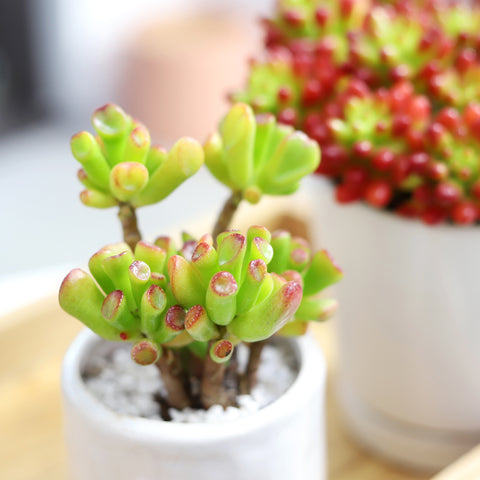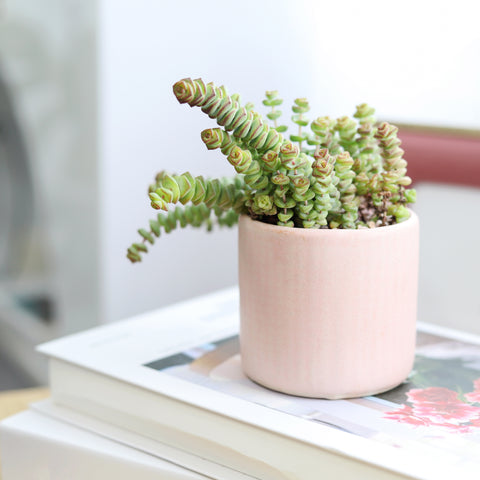Crassula is a genus of succulent plants belonging to the family Crassulaceae, which includes over 200 species native to many parts of the world, primarily concentrated in Southern Africa and Madagascar. These plants are known for their diverse forms, ranging from low-growing ground covers to tree-like shrubs. Crassula species exhibit various leaf shapes, colors, and textures, making them popular choices for succulent enthusiasts and collectors. They are often cultivated for their ornamental value and adaptability to diverse growing conditions. Some common species of Crassula include Crassula ovata (Jade Plant), Crassula perforata (String of Buttons), and Crassula capitella (Red Pagoda).
Crassula succulents are generally considered hardy plants, capable of tolerating a variety of growing conditions. They are often prized for their resilience and adaptability, making them suitable choices for both novice and experienced succulent growers. However, the hardiness of Crassula species can vary depending on the specific variety and its native habitat. Some Crassula species are more tolerant of extreme temperatures, drought, and neglect than others, making them particularly well-suited to challenging growing environments. Overall, while Crassula succulents are known for their hardiness, it's essential to research the specific care requirements of each species to ensure their optimal growth and health.
Crassulas have a rich history of cultivation, dating back centuries. They were traditionally grown for their ornamental value and often featured in rock gardens, succulent collections, and as indoor houseplants. Over time, as succulents have gained a special place in the houseplant stardom worldwide, Crassula species have become a popular choice for plant lovers thanks to their adaptability to various growing conditions and their ability to thrive with minimal maintenance. Today, Crassulas continue to be cherished as beloved houseplants, prized for their unique forms, vibrant colors, and resilience, making them a staple in many homes and gardens around the globe.
Crassulas’ Special Characteristics
Crassula species exhibit several distinctive characteristics that set them apart from other succulent genera. One notable feature is their diverse growth habits and leaf shapes, ranging from compact rosettes to sprawling or tree-like forms. Additionally, many Crassula species have thick, fleshy leaves arranged in opposite pairs along the stems, giving them a unique appearance. Some Crassula varieties also produce attractive flowers, often in clusters or panicles, adding to their ornamental appeal.

Crassula species have thick, fleshy leaves arranged in opposite pairs along the stems, giving them a unique appearance.
Another characteristic of Crassula plants is their ability to tolerate a wide range of growing conditions, from bright sunlight to partial shade, making them versatile choices for indoor and outdoor cultivation. Additionally, many Crassula species are relatively easy to propagate from stem or leaf cuttings, allowing for easy propagation and expansion of plant collections. Overall, the diverse forms, interesting foliage, and adaptability of Crassula species make them popular choices among succulent enthusiasts and collectors.
Toxicity
Crassula plants vary in toxicity depending on the species. While some, like the well-known Jade plant (Crassula ovata), can be toxic if ingested, many other Crassula species are non-toxic. However, it's essential to exercise caution with all Crassula varieties and keep them out of reach of pets and children. Even non-toxic plants can cause discomfort or gastrointestinal issues if consumed in large quantities. Therefore, it's advisable to handle all plants carefully and be mindful of their placement in your home or garden. If you suspect that a person or pet has ingested a Crassula plant and is experiencing adverse effects, seek medical or veterinary attention promptly.
General Care
Lighting
In their natural habitat, Crassula species typically grow in sunny, arid environments, so they are well-adapted to bright light conditions. They prefer bright, indirect sunlight for optimal growth. While they can tolerate some direct sunlight, particularly in the morning or late afternoon when the rays are less intense, prolonged exposure to harsh sunlight may cause their leaves to burn or become discolored. These plants need 6-8 hours of light daily.
If natural light is limited, using grow lights can help meet their requirements. When grown indoors, placing Crassula plants near a window where they can receive ample sunlight is ideal. However, it's essential to strike a balance and avoid exposing them to intense, direct sunlight, especially during the hottest part of the day, as this can lead to sunburn and damage to the leaves. If outdoor conditions permit, Crassulas can also thrive on balconies, patios, or in gardens where they can benefit from natural sunlight. Regularly rotating the plants or providing filtered light during the hottest hours can help prevent leaf damage and ensure healthy growth. Overall, providing sufficient light is key to promoting robust growth and vibrant foliage in Crassula plants.

Crassulas can also thrive on balconies, patios, or in gardens where they can benefit from natural sunlight.
Watering
Crassula plants have moderate watering needs and are sensitive to overwatering, so it's essential to water them carefully. Allow the soil to dry out partially between waterings, as Crassulas are susceptible to root rot if kept too wet. Regularly check the soil moisture level by inserting your finger into the soil up to the first knuckle. If the soil feels dry at this depth, it's time to water. When watering, thoroughly saturate the soil, ensuring that excess water drains away freely from the pot. Avoid leaving the plant sitting in water, as this can lead to waterlogged soil and root problems.
In addition to monitoring the soil moisture, it's essential to consider the plant's overall environment when determining watering frequency. Factors such as temperature, humidity levels, and air circulation can influence how quickly the soil dries out. During hot or dry weather, Crassula plants may require more frequent watering to prevent dehydration, while cooler or more humid conditions may necessitate less frequent watering.
When watering, it's best to use room temperature or lukewarm water to avoid shocking the plant's roots. Water the soil directly at the base of the plant, avoiding wetting the leaves to prevent fungal diseases and water spots. As a general rule, it's better to underwater than overwater Crassula plants, as they are more tolerant of drought than excessive moisture.
During the winter months, Crassula plants enter dormancy to conserve energy during periods of low light and cooler temperatures. During this time, their metabolic activity slows down, leading to reduced water uptake. As a result, you should reduce the frequency of watering to prevent overwatering and root rot
Soil And Fertilizer
Crassula plants thrive in well-draining soil that allows excess water to flow freely and prevents waterlogged conditions, which can lead to root rot. A suitable potting mix for Crassula plants consists of a combination of coarse sand, perlite, and peat moss or coconut coir. This mix provides adequate aeration and drainage while retaining some moisture to keep the roots hydrated. You can also use a commercial succulent or cactus potting mix, which is specifically formulated to meet the needs of succulent plants like Crassula. Avoid using heavy or moisture-retentive soils, as they can cause waterlogged conditions and lead to root rot.
In terms of fertilizing, Crassula are succulents and do not require heavy feedings. To boost growth, you can use a balanced, water-soluble fertilizer diluted to half or quarter strength. Apply the fertilizer once a month or every six weeks during the growing season, following the instructions on the product label for dilution and application rates. When applying fertilizer, always water the plant thoroughly before and after fertilizing to prevent root burn and ensure proper nutrient uptake. Additionally, avoid overfertilizing, as excessive fertilizer can build up in the soil and cause salt buildup, leading to root damage and nutrient imbalances. During dormancy in fall and winter, when Crassula plants are less active, withhold fertilizer altogether to avoid stimulating new growth during this period of rest. You can resume fertilizing in spring when the plant begins actively growing again.
Temperature And Humidity
Crassula plants prefer warm environments and they thrive in temperatures ranging from 65°F to 75°F during the day. They can tolerate slightly cooler temperatures at night, down to around 50°F to 60°F. Avoid exposing Crassula plants to temperatures below 50°F for extended periods, as they may become susceptible to cold damage and frost.

Crassula plants prefer warm environments and they thrive in temperatures ranging from 65°F to 75°F during the day.
Crassulas are known for their adaptability to a wide range of humidity levels, making them well-suited for most indoor environments. They typically thrive in humidity levels ranging from 30% to 50%. While they can tolerate moderate to high humidity, it's essential to avoid excessively high humidity, as it can create stagnant air and increase the risk of mold issues. In environments with higher humidity, ensuring adequate air circulation around the plants is crucial to prevent moisture buildup and promote healthy growth. Overall, Crassulas are not overly sensitive to humidity variations and can thrive in indoor conditions with moderate humidity levels.
Potting And Repotting
When potting or repotting Crassula plants, it's important to choose a well-draining potting mix specifically formulated for succulents and cacti. This ensures that excess water can easily drain away, preventing the risk of root rot. As succulents need good drainage and aeration, the best containers for Crassulas are the ones made from a porous material like cement, ceramic, or terra cotta.
As a general guideline, Crassula plants benefit from repotting every 2-3 years or when they outgrow their current container. Repotting during the spring or early summer months is ideal, as this is when the plant is actively growing and can recover more quickly from the process. With proper potting and repotting techniques, Crassula plants can continue to thrive and flourish in their new containers.
When repotting, gently remove the plant from its current container, taking care not to damage the roots. Inspect the roots for any signs of rot or damage, and trim away any unhealthy portions with sterilized scissors or pruning shears. Select a new pot that is slightly larger than the previous one, allowing room for the plant to grow but not too large, as large pots may lead to overwatering issues. Place the newly repotted Crassula in a location with bright, indirect sunlight to help it recover and settle down in its new container.
Pruning
Pruning is an essential part of Crassula care to maintain the plant's shape, encourage new growth, and remove any dead or damaged foliage.

- Start by deadheading spent flowers, removing them at the base of the stem to redirect the plant's energy.
- Trim any leggy stems to promote a more compact growth habit, using clean, sharp pruning shears.
- Regularly inspect the plant for dead, yellowing, or damaged leaves, removing them close to the main stem to prevent disease spread.
- Shape the plant by pruning back overgrown or unruly stems to maintain its appearance.
- Propagate new plants from cuttings by allowing healthy stems or leaves to callus over for a few days before planting them in well-draining soil.
When pruning, use caution to avoid damaging the plant and only remove a moderate amount of foliage at a time to prevent stress. With regular pruning, you can keep your Crassula healthy, vibrant, and visually appealing.
Propagation
Propagating Crassula succulents offers several methods. One common approach is stem cuttings, where you select a healthy stem from the parent plant, preferably one with a node or leaf attachment point. Use sharp, sterilized scissors or pruning shears to make a clean cut, ensuring the stem is at least a few inches long. Allow the cut end to callus over for a few days in a dry, shaded area to prevent rotting. Once calloused, plant the cutting in a well-draining succulent soil mix, burying the cut end slightly and keeping the soil lightly moist until roots form.
Leaf cuttings are another popular method, particularly for species with fleshy leaves. Gently twist or cut a healthy leaf from the parent plant, ensuring it's intact and without damage. Lay the leaf flat on a dry surface for a few days to allow the cut end to callus over. Then, place the leaf on top of moist succulent soil or perlite, ensuring the cut end is in contact with the soil. Mist the soil lightly to keep it moist, but avoid overwatering, as this can lead to rot. With time, roots will emerge from the base of the leaf, eventually giving rise to a new plant.
Division is suitable for Crassula species that produce offsets or pups around the base of the parent plant, for example Crassula ovata, Crassula perforata or Crassula capitella. Carefully remove these offsets, ensuring they have their own roots or at least a portion of the root system attached. Plant each offset in its own pot with well-draining soil, keeping it lightly moist until established. Provide warmth, indirect sunlight, and patience as the new plants take root and grow.
Regardless of the propagation method chosen, it's crucial to provide optimal conditions for root development and establishment. This includes providing bright, indirect light, warmth, and avoiding overwatering, which can cause rotting. Regular monitoring of soil moisture and adjusting care as needed will help ensure successful propagation and healthy growth of new Crassula plants.
Blooming
Crassula succulents are known for their charming flowers, which add to their ornamental appeal. While not all Crassula species bloom, many produce delicate clusters of small, star-shaped flowers in shades of white, pink, or red. These flowers typically emerge from the tips of the stems or in compact clusters above the foliage, creating a stunning display.
The flowering period varies depending on the species and growing conditions but often occurs during the spring or summer months. While the flowers are relatively short-lived, they add a beautiful accent to the plant's overall appearance and can attract pollinators such as bees and butterflies. Regular care, including proper light, watering, and fertilization, can encourage Crassula succulents to bloom, rewarding growers with their delightful floral display.
Common Problems
Common problems encountered when caring for Crassula succulents include:
- Overwatering: Crassula plants are susceptible to root rot if their soil remains consistently moist. Ensure proper drainage and allow the soil to dry out between waterings to prevent waterlogged conditions.
- Sunburn: While Crassula species appreciate bright light, prolonged exposure to intense sunlight can cause sunburn, resulting in discolored or scorched leaves. Provide filtered sunlight or shade during the hottest part of the day to prevent leaf damage.
- Leggy Growth: Insufficient light can cause Crassula plants to become leggy or stretched out as they reach for light. Ensure adequate sunlight exposure or provide supplemental grow lights to promote compact, healthy growth.
- Root Rot: Overwatering or poorly draining soil can lead to root rot, a fungal disease that causes the roots to decay. To prevent root rot, use a well-draining potting mix and water sparingly, allowing the soil to dry out between waterings.
- Yellowing Leaves: Yellowing leaves may indicate various issues, including overwatering, nutrient deficiencies, or pest infestations. Assess your plant's care routine and growing conditions to identify and address the underlying cause of leaf yellowing.
- Drooping or Wilting: Crassula plants may droop or wilt if they are underwatered or exposed to extreme temperatures. Adjust your watering schedule and ensure consistent environmental conditions to help your plants recover.






























